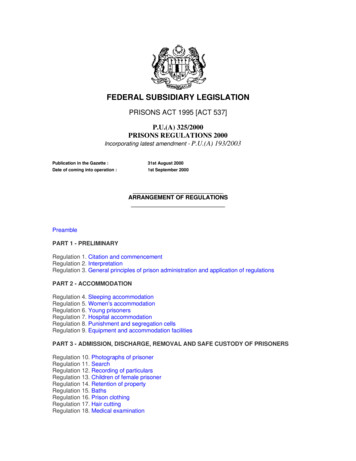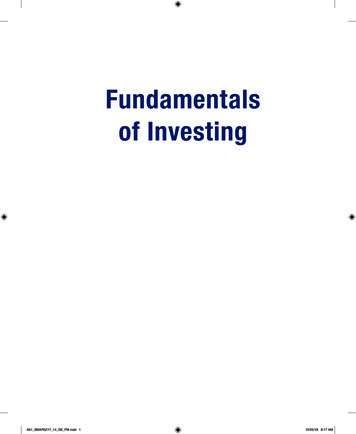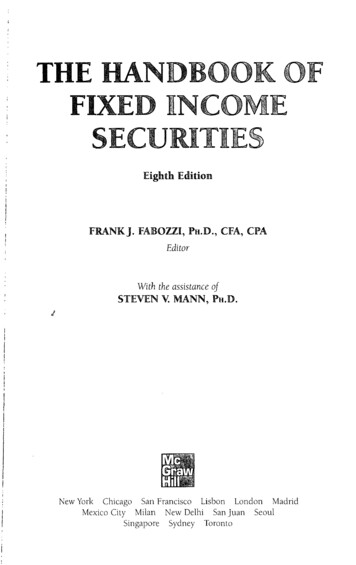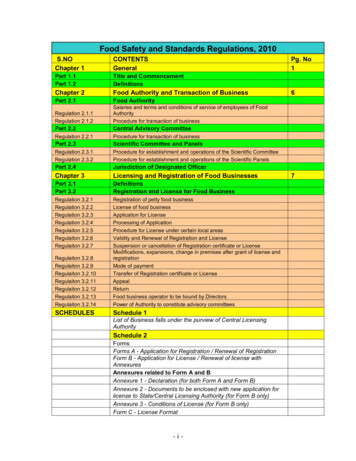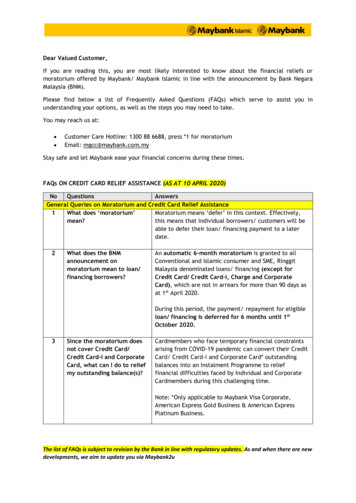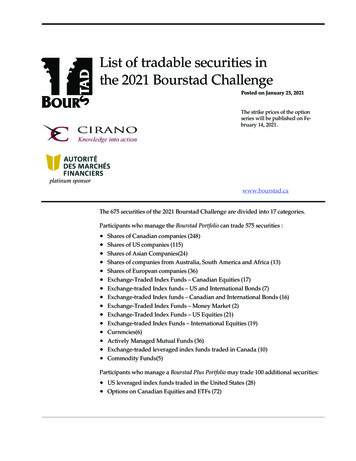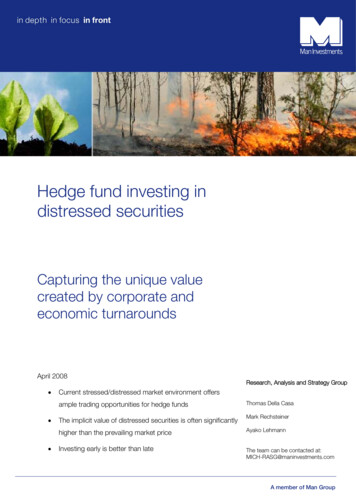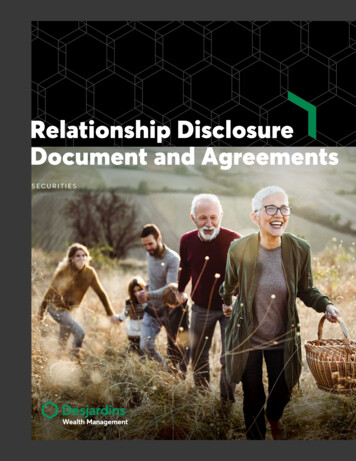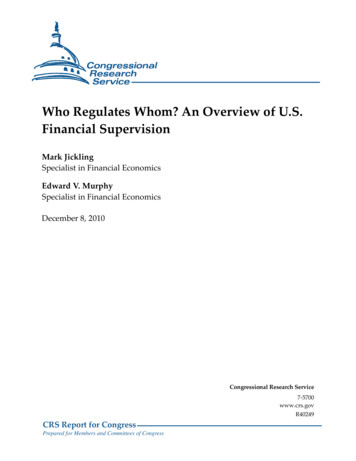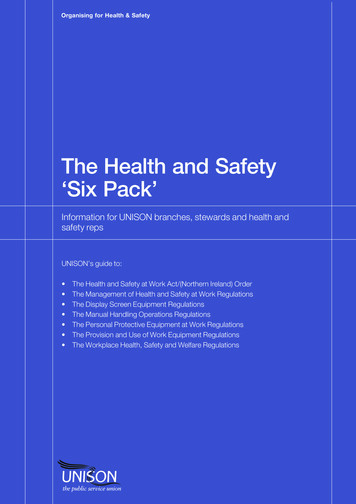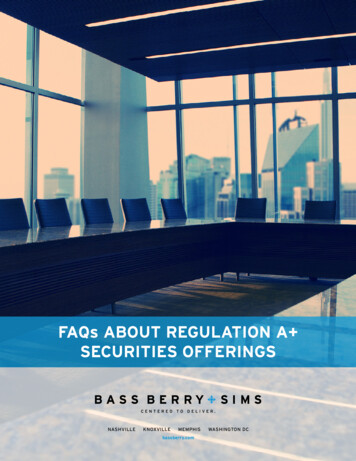
Transcription
FAQs ABOUT REGULATION A SECURITIES HINGTON DC
1.WHAT IS REGULATION A ?Regulation A is the colloquial name given to a recentlyadopted SEC rule that amended and expanded a rarely usedoffering exemption named Regulation A. Regulation A can be thought of as an alternative to a small registeredIPO and as either an alternative or a complement to othersecurities offering methods that are exempt from registrationunder the Securities Act of 1933. As amended, Regulation A provides an exemption for non-public U.S. and Canadiancompanies to raise up to 50 million in a 12-month period.The rules also make the exemption available, subject tolimitations on the amount, for the sale of securities byexisting stockholders. The new rules modernize the existingRegulation A framework by, among other things, requiringdisclosure documents be filed on EDGAR, allowing theconfidential review of offering documents, and permittingcertain “testing the waters” communications.4.The Regulation A offering process is initiated when acompany “files” an offering statement known as Form1-A with the SEC. After SEC review, the Form 1-A offeringstatement is declared “qualified” by a “notice ofqualification” (as opposed to “effective” in a traditional IPOcontext). After a Regulation A offering statement has been“qualified,” companies may begin selling securities.Companies that have not previously sold securities under aqualified Regulation A offering may submit a draft offeringstatement for confidential SEC staff review. The non-publicdraft offering statement and any amendments to it must bepublicly filed on EDGAR no less than 21 calendar days prior tothe qualification of the public filing.5.Regulation A provides two tiers of offerings:Tier 2, which consists of securities offerings of up to 50million in any 12-month period.2.WHICH COMPANIES ARE ELIGIBLE TO USEREGULATION A ?The exemption is generally available to any non-public U.S.and Canadian company. However, the following issuers arenot eligible to use the exemption:an investment company registered or required to beregistered under the Investment Company Act of 1940 ora business development company as defined inSection 2(a)(48) of the Investment Company Act of 1940;a blank check company; andan issuer that is disqualified under the SEC’s “bad actor”disqualification rules.3.WHAT ARE DIFFERENCES BETWEEN A TIER 1OFFERING AND A TIER 2 OFFERING?Tier 1 and Tier 2 offerings under Regulation A havedifferent requirements concerning financial statements,ongoing reporting obligations and investor eligibilitystandards. The table on the following page highlights thekey provisions of Tier 1 and Tier 2 offerings.Tier 1, which consists of securities offerings of up to 20million in any 12-month period, andFor offerings of up to 20 million, the issuer could electwhether to proceed under Tier 1 or Tier 2. According to aNovember 2016 study, around 60 percent of companies whouse Regulation A use a Tier 2 offering. See the questionbelow titled, “What are differences between a Tier 1 offeringand a Tier 2 offering?” for additional information about Tier1 and Tier 2 offerings.WHAT IS THE GENERAL PROCESS FOR A REGULATIONA OFFERING?6.ARE THERE ANY OFFERING COMMUNICATIONRESTRICTIONS?A company engaged in a Regulation A offering hassubstantial flexibility regarding offering communications. Atany time before the qualification of the offering statement,including the filing of the offering statement with the SEC,a company or any person authorized to act on behalf of acompany may communicate orally or in writing withpotential investors to determine whether there is anyinterest in the contemplated securities offering. This isreferred to as “testing the waters.” Testing the watersinvolves oral or written communications to determinewhether prospective investors could be interested in theoffering. By soliciting potential investors, businesses cangauge the market interest in their securities before formallylaunching the offering. Testing the waters may not involvesolicitation or acceptance of payment or a commitment tofuture payment for securities. The anti-fraud provisions ofthe federal securities laws apply to these communications aswell as certain legend requirements.WHAT SECURITIES ARE ALLOWED TO BE SOLD?The securities that may be offered under Regulation A are limited to equity securities, including warrants, debtsecurities and debt securities that are convertible into orexchangeable into equity interests, including guarantees ofsuch securities.1
KEY PROVISIONS OF TIER 1 VS TIER 2 OFFERINGSTIER 1 OFFERINGTIER 2 OFFERING 20 million, including no more than 6 million on behalfof selling securityholders that are affiliates of the issuer. 50 million, including no more than 15 million on behalfof selling securityholders that are affiliates of the issuer.No preemption.Preemption of state securities law registration andqualification requirements for securities offered or sold to“qualified purchasers,” which is defined to be any personto whom securities are offered or sold in a Tier 2 offering,or where securities are listed on a national securitiesexchangeLimitations on InvestorsNo limit.Impose an investment limit for non-accredited investors.A non-accredited investor may invest no more than: (1)10 percent of the greater of annual income or net worth(for natural persons); or (2) 10 percent of the greaterof annual revenue or net assets at fiscal year-end (fornon-natural persons). The investment limit does not applyif the securities are to be listed on a national securitiesexchange at the consummation of the offering.SEC Filing Requirements Issuers must file with the SEC a Form 1-A (named, theOffering Circular), which is reviewed and qualifiedwith the SEC. Confidential SEC review of the Offering Circular ispermitted, so long as the Offering Circular is publiclyfiled not later than 21 calendar days beforequalification. Permit continuous or delayed offerings.Same as Tier 1.SolicitationMaterialsIssuers may “test the waters” with the general publiceither before or after the filing of the Offering Circular.Same as Tier 1.Annual Offering LimitsPreemption of StateSecurities LawsRequired FinancialStatementsPeriods: Balance sheets and related financial statements forthe two previous fiscal year ends (or for such shortertime that they have been in existence). Financial statements must be dated not more thannine months before the date of non-public submission,filing or qualification, with the most recent annual orinterim balance sheet not older than nine months. Ifinterim financial statements are required, they mustcover a period of at least six months. Unaudited. The financial statements prepared forTier 1 offerings need not be audited. However, if anaudit was obtained for other purposes and that auditwas performed in accordance with U.S. generallyaccepted auditing standards or the standards of thePublic Company Accounting Oversight Board (PCAOB)by an independent auditor, those audited financialstatements must be filed. The auditor does not need /to be registered with the PCAOB.OngoingReporting2Tier 1 offerings require a company to file an exit reporton EDGAR not later than 30 calendar days aftertermination or completion of an offering. Periods: Same as Tier 1. Audited. The financial statements prepared for Tier 2offerings must be audited in accordance witheither U.S. generally accepted auditing standards or thestandards of the PCAOB by an independent auditor. Theauditor does not need to be registered with the PCAOB.Interim financial statements may be unaudited.Tier 2 offerings require a company to file annual andsemiannual reports, as well as current event reports, onEDGAR.
7.Companies who complete a Tier 1 offering are not required tofile ongoing reports with the SEC, other than an exit report(Form 1-Z) at the completion of an offering.Companies who complete Tier 2 offerings are subject to anongoing reporting regime and are required to file annual,semi-annual and current event reports with the SEC. Tier 2companies are required to file:Annual reports on Form 1-K;Semi-annual reports on Form 1-SA;Current reports on Form 1-U;Special financial reports on Form 1-K and Form 1-SA; andExit reports on Form 1-Z.The Form 1-K annual report is due within 120 calendar days ofthe company’s fiscal year end and requires disclosures aboutthe company’s business and operations for the precedingthree fiscal years (or since inception if less than three years),related-party transactions, beneficial ownership, executiveofficers and directors, executive compensation, MD&A, andtwo years of audited financial statements. The Form 1-SAsemi-annual report is similar to a Form 10-Q, although withscaled disclosure requirements. The current report on Form1-U is required to announce fundamental changes in thecompany’s business, entry into bankruptcy or receivershipproceedings, material modifications to the rights of securityholders, changes in accountants, non-reliance on auditedfinancial statements, changes in control, changes in keyexecutive officers, and sales of 10 percent or more ofoutstanding equity securities in exempt offerings. Form 1-Umust be filed within four business days of the triggeringevent.8.The rules also address abandoned offerings in much thesame way that these are handled by Rule 155, with a 30-daycooling-off period.ARE THERE ANY ONGOING REPORTINGREQUIREMENTS?WILL THE OFFERING BE INTEGRATED WITH PREVIOUSOR FUTURE SECURITIES OFFERINGS?Regulation A offerings will not be integrated with any prioroffers or sales of securities. Subsequent offers and sales ofsecurities will not be integrated with securities offerings thatareregistered under the Securities Act, except as provided inRule 255(e) (related to abandoned offerings),made in reliance on Rule 701,made pursuant to an employee benefit plan,made in reliance on Regulation S,made pursuant to Section 4(a)(6) of the Securities Act(crowdfunded offerings), ormade more than six months after completion of theRegulation A offering.9.AFTER THE OFFERING, WILL THE SECURITIES BEFREELY TRADEABLE?Yes, the securities sold in a Regulation A offering are notconsidered “restricted securities” under Securities Act Rule144. As a result, sales of securities by persons who arenot affiliates of the issuer are not subject to any transferrestrictions under Rule 144. Affiliates continue to be subjectto the limitations of Rule 144, other than the holding periodrequirement. This is important when an issuer seeks todevelop an active trading market for its securities. However,the company’s securities may not be listed or quoted on asecurities exchange without registration under Section 12(b)of the Exchange Act. See the question below titled, “Can thecompany also list its securities on the NYSE or Nasdaq fortrading?” for additional information.10. IF THERE ARE TOO MANY SHAREHOLDERS AFTERTHE OFFERING, WILL THE COMPANY NEED TOREGISTER ITS CLASS OF SECURITIES UNDERSECTION 12(g) OF THE SECURITIES EXCHANGEACT OF 1934?Section 12(g) of the Securities Exchange Act of 1934 providesthat an issuer must register a class of equity securities withthe SEC if, on the last day of the issuer’s fiscal year, the issuerhad total assets in excess of 10 million and a class ofequity securities held of record by either (1) 2,000 personsor (2) 500 persons who are not accredited investors. In thecase of a bank, savings and loan holding company, or a bankholding company with total assets in excess of 10 million,Section 12(g) requires the issuer to register any class of equitysecurities held of record by 2,000 or more persons.Regulation A provides a limited exemption for securitiesissued in a Tier 2 offering from this Section 12(g) holder ofrecord threshold when the issuer is subject to, and current in,its Regulation A periodic reporting obligations. To benefitfrom this conditional exemption, an issuer must retain theservices of a transfer agent and have a public float of lessthan 75 million or, in the absence of a float, revenues of lessthan 50 million. An issuer that exceeds the Section 12(g)threshold will have a two-year transition period before it isrequired to register its class of securities under Section 12(g)of the Exchange Act.11. CAN THE COMPANY ALSO LIST ITS SECURITIES ONTHE NYSE OR NASDAQ TRADING?Yes. Regulation A permits an issuer in a Tier 2 offeringto voluntarily register a class of Regulation A securitiesunder the Exchange Act. In the absence of the relief3
provided in the rules, an issuer that completed a RegulationA offering and sought to list a class of securities on a nationalsecurities exchange would have incurred the costs and thetiming delays associated with preparing and filing a separatelong form registration statement on Form 10. A companyengaged in a Tier 2 offering that has provided disclosure in PartII of Form 1-A that complies with Part I of Form S-1 (or for REITs,Form S-11) is permitted to file a Form 8-A short formregistration statement to list its securities on a nationalsecurities exchange. This short form registration statementprocess is similar to a traditional IPO where a Form 8-A isfiled along with a Form S-1 (or S-11 for REITs). A company thatfollows this path would thereafter be subject to ExchangeAct reporting requirements and enters the reporting regimeas an emerging growth company.12. WHERE CAN I FIND MORE INFORMATION?The adopting release for Regulation A can be found here.The Form 1-A offering circular can be found here.Bass, Berry & Sims’ Blueprint for an IPO can be downloadedhere.For more information about this topic, please reach out to anymember of our Corporate & Securities Practice Group.AUTHORSJAY H. KNIGHTMember(615) 742-7756jknight@bassberry.comWILLIAM N. LAYAssociate(615) 742-7829william.lay@bassberry.comThis publication is intended to be used for informational purposes only, and is not intended to be legal advice.4
NASHVILLEK N OXV I L L EMEMPHISWA S H I N G T O N D Cbassberry.com
develop an active trading market for its securities. However, the company's securities may not be listed or quoted on a securities exchange without registration under Section 12(b) of the Exchange Act. See the question below titled, "Can the company also list its securities on the NYSE or Nasdaq for trading?" for additional information. 10.
